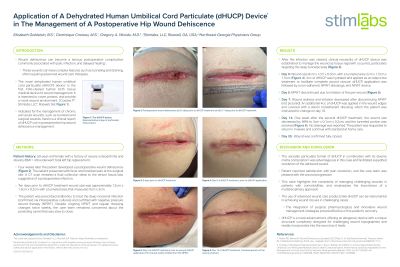Case Series/Study
(CS-054) Application of a Dehydrated Human Umbilical Cord Particulate (dHUCP) Device* in the Management of a Postoperative Hip Wound Dehiscence
Friday, May 2, 2025
7:45 PM - 8:45 PM East Coast USA Time

Dominique Croteau, MS – Scientist, StimLabs; Gregory Woods, MD – Physician, Orthopaedic Surgery
Introduction: Wound dehiscence can become a serious postoperative complication commonly associated with pain, infection, and delayed healing. These wounds can have complex features such as tunneling and draining, often requiring advanced wound care therapies. As the first FDA-cleared human birth tissue medical device for wound management, the novel dehydrated human umbilical cord particulate (dHUCP) device* is intended to cover, protect, and provide a moist wound environment. Indicated for the management of chronic and acute wounds, such as tunneled and surgical wounds, herein reports a clinical example of dHUCP use in postoperative hip wound dehiscence management.
Methods: A 59-year-old female underwent total left hip replacement and later developed a postoperative wound dehiscence. The patient’s primary complaint was pain of the left hip. Initial wound size was approximately 12x1.5x0.2cm with a tunneled area that measured 3x3cm. The patient was prescribed vibramycin to treat deep incisional infection and outfitted with negative pressure wound therapy (NPWT). While NPWT was noted to aid wound healing progress overall, the care team remained concerned about the persisting tunnel. After the infection was cleared, dHUCP was implemented to manage the wound as tissue regrowth occurred in that region. dHUCP was hydrated and applied to the wound bed, covered with a non-adherent dressing and NPWT. A week later, NPWT was discontinued, and a second application of dHUCP was administered to the wound. The decreased wound severity at this stage enabled the care team to allow the patient to perform dressing changes herself as part of home care.
Results: Two weeks after the second dHUCP treatment, the wound size decreased by 98% and the tunneled portion was resolved. Patient reported satisfaction with pain resolution, and the care team was pleased with the wound progression. The wound was confirmed closed by three weeks-post second dHUCP application.
Discussion: The versatile particulate format of dHUCP in combination with its diverse matrix composition was advantageous in this case and facilitated expedited resolution of the dehisced wound. dHUCP is a novel advancement, offering an allogeneic device with a unique structural complexity designed for challenging wound topographies and readily incorporates into the wound as it heals.
Methods: A 59-year-old female underwent total left hip replacement and later developed a postoperative wound dehiscence. The patient’s primary complaint was pain of the left hip. Initial wound size was approximately 12x1.5x0.2cm with a tunneled area that measured 3x3cm. The patient was prescribed vibramycin to treat deep incisional infection and outfitted with negative pressure wound therapy (NPWT). While NPWT was noted to aid wound healing progress overall, the care team remained concerned about the persisting tunnel. After the infection was cleared, dHUCP was implemented to manage the wound as tissue regrowth occurred in that region. dHUCP was hydrated and applied to the wound bed, covered with a non-adherent dressing and NPWT. A week later, NPWT was discontinued, and a second application of dHUCP was administered to the wound. The decreased wound severity at this stage enabled the care team to allow the patient to perform dressing changes herself as part of home care.
Results: Two weeks after the second dHUCP treatment, the wound size decreased by 98% and the tunneled portion was resolved. Patient reported satisfaction with pain resolution, and the care team was pleased with the wound progression. The wound was confirmed closed by three weeks-post second dHUCP application.
Discussion: The versatile particulate format of dHUCP in combination with its diverse matrix composition was advantageous in this case and facilitated expedited resolution of the dehisced wound. dHUCP is a novel advancement, offering an allogeneic device with a unique structural complexity designed for challenging wound topographies and readily incorporates into the wound as it heals.

.jpg)